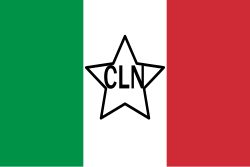
Back حركة المقاومة الإيطالية Arabic Resistencia italiana AST Италианска съпротива Bulgarian Resistència italiana Catalan La Resistenza Czech Resistenza German Ιταλική αντίσταση Greek Itala kontraŭnazia rezistmovado Esperanto Resistencia italiana Spanish جنبش مقاومت ایتالیا Persian
| Italian resistance | |
|---|---|
| Resistenza italiana (Italian) | |
  Flag of the National Liberation Committee and some members of the Italian resistance in Ossola, 1944 | |
| Leaders | |
| Dates of operation | 8 September 1943 – 25 April 1945 |
| Motives | Liberation of Italy from Nazism and Fascism |
| Headquarters | Rome |
| Active regions | Kingdom of Italy |
| Ideology | Various, including: |
| Allies | Kingdom of Italy Allies |
| Opponents | Nazi Germany Italian Social Republic |
| Battles and wars | the Italian campaign of World War II; involvement of Italian army and partisan units in Yugoslavia, Greece, Albania, and France. |
The Italian Resistance (Italian: Resistenza italiana, pronounced [reziˈstɛntsa itaˈljaːna], or simply La Resistenza) consisted of all the Italian resistance groups who fought the occupying forces of Nazi Germany and the fascist collaborationists of the Italian Social Republic during the Second World War in Italy from 1943 to 1945. As a diverse anti-fascist and anti-nazist movement and organisation, the Resistenza opposed Nazi Germany and its Fascist puppet state regime, the Italian Social Republic, which the Germans created following the Nazi German invasion and military occupation of Italy by the Wehrmacht and the Waffen-SS from 8 September 1943 until 25 April 1945.
General underground Italian opposition to the Fascist Italian government existed even before World War II, but open and armed resistance followed the German invasion of Italy on 8 September 1943: in Nazi-occupied Italy, the Italian Resistance fighters, known as the partigiani (partisans), fought a guerra di liberazione nazionale ('national liberation war') against the invading German forces; in this context, the anti-fascist partigiani of the Italian Resistance also simultaneously participated in the Italian Civil War, fighting against the Italian Fascists of the collaborationist Italian Social Republic.
The Resistance was a diverse coalition of various Italian political parties, independent resistance fighters and soldiers, and partisan brigades and militias. The modern Italian Republic was declared to be founded on the struggle of the Resistance: the Constituent Assembly was mostly composed of representatives of the parties that had given life to the Italian Resistance's National Liberation Committee. These former Italian Resistance fighters wrote the Constitution of Italy at the end of the war based on a compromissory synthesis of their Resistance parties' respective principles of democracy and anti-fascism.[1]
- ^ G. Bianchi, La Resistenza, in: AA.VV., Storia d'Italia, vol. 8, pp. 368–369.